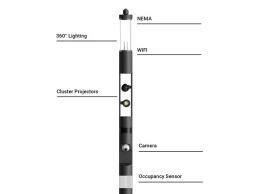
David Morgan Review: Ligman L-Column
David Morgan gets up close and personal with the latest product from Ligman, the L-Column intelligent light column. To be exhibited at Lightfair International, the L-Column combines lighting, security and smart city elements in one integrated system.
When a lighting company started in Bangkok in 1995 by Sakchai Manawongsakul, manufacturing high-quality exterior luminaires, grows into a global lighting manufacturer, it seems likely that there will be some interesting product developments in the works.
Now employing 520 people, with four factories, offices in thirteen countries and more than 100 distributors, recent expansions for Ligman included last year’s opening of its European factory in the Czech Republic and a new global headquarters building in Bangkok, alongside the first of a number of planned flagship stores opened in Bangkok and Singapore, as well as new Ligman offices in the UK, France and China.
The Ligman approach to luminaire design has been straightforward, with a focus on the commercial exterior lighting market. The product range has expanded over the years to cover both interior and exterior lighting. Products are well constructed, in most cases with a simple clean and geometric design aesthetic, and good lighting performance.
Martin Valentine was recruited in 2017 as Ligman’s Global Design Director to oversee the development of more complex lighting systems. Valentine’s extensive experience as a leading lighting designer in the UK, and as in-house consultant to the Abu Dhabi city, gives him a unique perspective for this new role with Ligman.
The first result of Valentine’s efforts is the L-Column intelligent light column, which combines a remarkably wide variety of lighting, security and smart city elements in one integrated system.
Valentine was heavily involved with the research and design of the L-Column since the idea was first raised. It took just under one year to bring this development through to manufacture and it was officially launched in March this year.
The research, design and development process for the range was undertaken by the in-house management team with Stephen Dunk heading product design, supported by input from an industrial design practice.
Valentine was keen to ensure the system offers excellent lighting performance and that the lighting elements would not be compromised in order to fit them within the pole diameter. A fully integrated visual appearance where all the elements share a common design language was also a key requirement.
The results of this do not disappoint. A circular 216mm diameter extruded base column has a minimum height of three metres and a maximum height of eight metres when fitted with the various lighting and other modules.
A variety of new lighting modules have been developed as part of the L-Column range and standard Ligman luminaires can also be incorporated. Ligman’s post top lanterns, such as Anesti, Laluna or Macaron, coordinate visually with the geometry of the column and will provide good urban ambient lighting to the base of the column.
The 360-degree luminaire module provides up to 6,000 lumens with an efficiency of up to 101 lumens per Watt. 3000K or 4000K 80 CRI LEDs are the standard options. Four lighting distributions are achieved with the use of optical controllers, including two elliptical distributions of 134 x 48 degrees and 134 x 54 degrees.
A Wifi hub can also be incorporated in this 360-degree luminaire module as part of a Smart City system.
Single and twin street lighting pole modules enable any of the thirteen ranges of Ligman street lighting luminaires to be mounted, although some of these designs will integrate visually better than others with the rest of the system.
Two sizes of aimable projector modules house either two or four LED projectors, which incorporate a COB LED light engine with four distributions. Anti-glare snoots and other accessories are available for these projectors. A decision was made not to enclose the projectors within a clear window detail in order to allow wider aiming angles to be achieved. Thermal management of the projectors will also be easier without any enclosure to trap heat.
It is understood that a number of additional lighting elements will be added in future, including colour-changing beacons that can be used for decorative, wayfinding or indicator functions.
The non-lighting elements include daylight and proximity sensors, CCTV with single and twin modules, a weather station, loudspeakers, an intercom and an electric vehicle charging station.
The Ligman L-Management system offers a complete addressable project lighting monitoring and control solution and can provide additional information to a control centre such as digital video surveillance, air pollution level monitoring, asset tracking and an intercom for face-to-face communication.
Assets can be tracked through RFID monitoring and security can be increased with the use of 360-degree zoomable surveillance cameras. The weather station and its pollution monitors will even allow a city to implement traffic calming policies and meet international WHO targets.
Using wireless technology, gateways and a data concentrator, street lights become smart, talking through a mesh network to the control centre. The hardware and software tools provided by Ligman provide live information to the control centre, allowing local authorities to monitor the health of the city by displaying not only the status of the luminaires but also the power consumption and usage.
L-Column is an ambitious addition to the Ligman range, which should enable more complex urban lighting projects to be undertaken. Although the range was only launched in March this year, I spotted it at LEDucation in New York, and the reaction so far from specifiers around the world has been very positive.
In less than 25 years Ligman has grown into a global player and developed a solid product range, which is why this is a company to watch and see what they deliver next.



